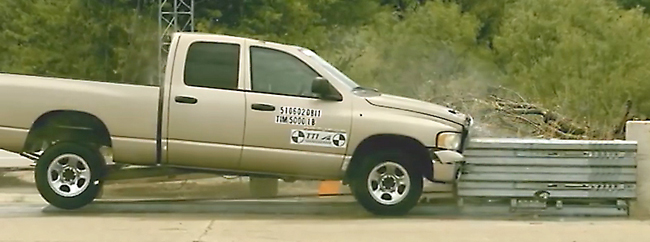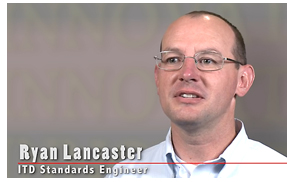

Lancaster’s crash-cushion innovation saves lives, infrastructure
Expense should not drive every decision — sometimes, the right fit does.
Ryan Lancaster in ITD’s Engineering Services simplified the process for selecting crash cushions, saving support structures for interchanges and overpasses, guardrail, and most importantly, lives. The crash cushions absorb the impact of crashing vehicles and re-direct the destructive energy. 
Safety is the top priority, Lancaster said. “We use guardrail, crash cushions, and other similar hardware to shield motorists from hazards like bridge piers, signs, cliffs, rivers and more. Secondary to that is the protection of infrastructure.”
Lancaster said that, even from the same manufacturer, there was a wide range of costs and performance for crash cushions. Some of the least expensive ones had to be replaced frequently. Some were comparable in cost, but much more durable.
Lancaster’s innovation allows the department to select crash cushions based on performance needs and the crash history of each site, which ultimately decreases life-cycle costs.
“After digging into it a little, I discovered we weren’t using all the products available on the market, and we weren’t using them in the smartest way,” Lancaster explained.

Lancaster began exploring a new way to assess and purchase crash cushions in 2012, and a new system rolled out in the spring of 2014, using different standards — maintenance and performance characteristics.
Lancaster put the crash cushions into three categories: sacrificial, partially reusable and low maintenance. The cushions that fall into the sacrificial category are lower initial cost, and used in areas where frequent crashes are not expected. “Hit ‘em once and throw it away,” said Lancaster.
The next category is partially reusable, meaning they are not a total loss when they get hit by a vehicle. “Some parts are still strong and useable,” Lancaster said.
The final category, low maintenance, has higher initial cost, but can be repaired quickly and cheaply. They are typically used in areas where more frequent crashes are expected.
“We may use them in areas where it is a long distance from any maintenance shed and it would take a long time to respond, and also areas of heavy traffic because we don’t want to expose workers any longer than necessary to the dangers of traffic passing closely by,” he added.
In the end, it is about finding the right solution for the right area. In the long run, that may prove cheaper, anyway.
Published 11-6-15